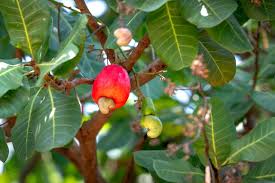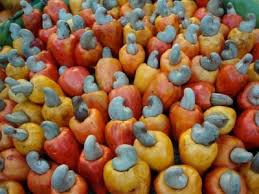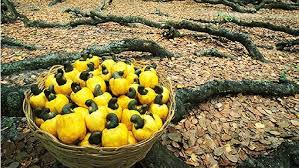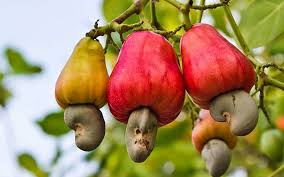The Cashew (Anacardium occidentale; syn. Anacardium curatellifolium A.St.-Hil.) is a tree in the flowering plant family Anacardiaceae. The plant is native to northeastern Brazil, where it is called by its Portuguese name, Caju (the fruit) or Cajueiro (the tree). It is now widely grown in tropical climates for its cashew “nuts” and cashew apples.
It is a small evergreen tree, growing 10-12 m tall, with a short, often irregularly shaped trunk. The leaves are spirally arranged, leathery in texture, elliptic to obovate, 4 to 22 cm long, and 2 to 15 cm broad, with a smooth margin.
The flowers are produced in a panicle or corymb up to 26 cm long. Each flower is small, pale green at first, then turns reddish, with five slender, acute petals measuring 7 to 15 mm long.
The visible fruit of the cashew tree is an oval or pear-shaped accessory fruit, or false fruit, that develops from the receptacle of the cashew flower. This structure is called the cashew apple, also known as “marañón” in Central America, which ripens into a yellow and/or red fruit about 5–11 cm long.
The true fruit of the cashew tree is a kidney or boxing-glove-shaped drupe that grows at the end of the pseudofruit. The drupe develops first on the tree, and then the peduncle expands into the pseudofruit. Inside the true fruit is a single seed, the cashew nut.
Although referred to as a nut in the culinary sense, botanically, the fruit of the cashew is a seed. Some botanists classify the true fruit as a nut. The seed is surrounded by a double shell containing a caustic phenolic resin called urushiol, which is a potent skin irritant (also found in poison ivy). Cashews can cause allergies, although they are less frequent allergens compared to some other nuts.
Vernacular Names of Cashew
Other vernacular names for cashew include cajueiro, cashu, casho, acajuiba, caju, acajou, acaju, acajaiba, alcayoiba, anacarde, anacardier, anacardo, cacajuil, cajou, gajus, jocote maranon, maranon, merey, noix d’acajou, pomme cajou, pomme, jambu, jambu golok, jambu mete, jambu monyet, jambu terong, and kasoy.
In the Antilles, specifically Puerto Rico, it is known as pajuil, where the pseudofruit is the main part used as raw fruit. Cashew is an important economic crop cultivated in plantations.
Read Also: 11 Medicinal Health Benefits of Barbarea vulgaris (Yellow Rocket)
Origin and Spread of Cashew

The first sighting of the cashew tree by westerners was by the Portuguese, who invaded Brazil in the 1500s. Portuguese seamen brought the seeds of the cashew tree from Brazil to be planted by early settlers along the east coast of Africa. The trees took root and thrived, eventually growing wild along the entire coast of Mozambique and spreading to Kenya and Tanzania.
Initially uncared for and uncultivated, the ripe nuts were harvested primarily by African natives and sold to Portuguese traders. These traders then sold the nuts to merchants, who shipped them to India for shelling.
Over time, India began cultivating its own cashew trees. Today, the Kerala State (India) Cashew Association is the largest exporter of cashews in the world, followed by Forteleza, Brazil. These two regions represent over 80 percent of the world’s supply, which is around 4 million cases (50 pounds per case). Africa ranks a distant third. The cashew crop in India is harvested in May, while the Brazilian crop is harvested in October.
Cashew Tree Characteristics and Pollination
The cashew tree is small to medium in size, generally single-trunked, and spreading in habit, growing up to 40 feet in height but typically reaching 10-20 feet in cultivation. Older trees may spread wider than they are tall, with lower limbs bending to touch the ground. The leaves are thick, prominently veined, and oval to spatulate in shape, with blunt tips and entire margins. New foliage contains a reddish pigment.
Flowering in the cashew tree is similar to its relative, the mango tree. Both male and perfect flowers are borne on the same inflorescence (polygamous). Individual flowers are about 1/4 inch across, with crimson petals often striped longitudinally and reflexed.
They are borne terminally on panicles, generally at the beginning of the dry season. Flowering may continue for several weeks, and it is common to see ripening fruit and flowers on the tree simultaneously.
Cashew trees are at least partially self-fruitful, as single trees can bear many fruits. A study of pollination biology showed no difference in pollen tube growth between self-pollinated and cross-pollinated flowers, although final yields were higher with cross-pollination.
Cashews are often grown from seed, and cross-pollination in orchards occurs to a high degree. Fruit set is highest in flowers that open first, suggesting a form of apical dominance, similar to the pistachio tree. Pollination is carried out by various insects, including flies and ants.
Cashew Fruit and Nut Development

The true botanical fruit of the cashew tree is a nut, about 1 inch long, shaped like a small boxing glove, hanging below the fleshy, swollen peduncle known as the cashew apple or pseudo-fruit. The cashew apple resembles a pear in shape and size, is juicy, fibrous, and astringent in taste. It has thin skin that is either yellow or light red in color, with yellow flesh. Fruits are borne singly or in small clusters and mature in 60-90 days. The nut develops first, followed by the rapid swelling of the cashew apple in the final weeks.
Agro-Climatic and Edaphic Requirements for Cashew Trees
1. Climate: Cashew trees require a warm, humid climate, with a minimum rainfall of 600 mm. However, evenly distributed rainfall is more important for optimal growth. Cashew trees thrive in temperatures ranging from 15°C to 40°C but do not grow well in areas prone to frost or cold waves. Cashew is also drought-resistant.
2. Soil Requirements: Cashew trees are known for their ability to grow in soils that are generally unsuitable for other fruit trees, particularly sandy soils. For the best production, deep, well-drained sandy or sandy-loam soils are recommended. Cashew trees do not tolerate poorly drained soils. They can also grow on hilly slopes up to an elevation of 700 m above mean sea level, making these areas suitable for cashew cultivation.
Nursery Management in Cashew
1. Selecting and Planting Cashew Seeds: Fresh cashew seeds that sink in water are ideal for planting. The seeds should be planted in an upright position in planting bags filled with a loose, sterilized soil mixture.
Three to four seeds can be planted directly in the planting hole, and the weakest ones are later thinned out, leaving the strongest to grow further. It is important to use deep planting bags (350-400 mm) because the cashew tree’s taproot grows rapidly and will bend if it reaches the bottom.
2. Seedlings: Cashew seedlings should be grown under 45% shade and hardened off before planting in the orchard. The root system must not be disturbed during planting. Additionally, young trees should be supported for the first two to three years to prevent them from being blown over by the wind.
Establishment through Asexual Methods
1. Softwood Grafting: Cashew was traditionally propagated by seeds, but vegetative propagation is now recommended for higher and early yield. Softwood grafting is one of the most successful methods of vegetative propagation in cashew cultivation, achieving about 60% success.
2. Steps for Softwood Grafting:
i. Raising Seedlings for Rootstock: Collect uniform seed nuts from high-yielding trees during peak harvest (February to April). Use seeds with high specific gravity (1.025 to 1.05) for quick germination and vigorous seedlings. Prepare 30 cm x 20 cm polythene bags filled with a soil mixture (2:1:1 soil:sand:compost) and plant the seed nuts.
ii. Selection of Scion: Scions should be selected from high-yielding trees. They should be 8-10 cm long, straight, and have a pencil-thick diameter, with a brown color and dormant terminal bud.
iii. Grafting Procedure: Remove the leaves from the top portion of the seedling, cut the seedling transversely, and make a cleft in the middle of the decapitated stem. Prepare the scion by shaping it into a wedge and insert it into the cleft of the stock. Ensure the cambium layers of the scion and stock come in contact, then tie the graft joint with a polythene strip.
iv. After-care of the Graft: Grafted plants should be kept under shade and in humid conditions. Sprouting of the terminal bud will occur after 15-20 days. Water the grafts regularly and protect them from pests and diseases using appropriate insecticides and fungicides.
Cashew Orchard Establishment and Maintenance
1. Selection of Site and Land Development: When selecting land for cashew orchards, soils prone to salinity, alkalinity, or waterlogging should be avoided. Soil depth, slope, coarse texture, soil fertility, and water availability have minimal limitations, as cashew is a hardy crop. For establishing new plantations, land preparation should begin with the first pre-monsoon rains. The land should be cleared of shrub vegetation before digging pits for planting.
2. Planting Season: Planting of grafted plants typically occurs during the monsoon season from July to August, both on the west and east coasts. Pits for grafted plants should be prepared well in advance of the main monsoon season.
3. Spacing and Planting Systems: A recommended spacing for cashew trees is 7.5m x 7.5m or 8m x 8m, which provides a tree density of 175 and 156 trees per hectare, respectively. High-density planting at 4m x 4m (625 trees per hectare) is practiced in some areas, with thinning performed in stages to reach the final spacing of 8m x 8m. In level sites, a spacing of 10m x 5m, with a density of 200 trees per hectare, allows sufficient space for intercropping during the early establishment years.
4. Field Planting of Cashew: Pits, typically 60cm x 60cm x 60cm in size, are dug at the onset of the pre-monsoon rains. In soils with a hard substrate, such as laterite, pits may be 1m x 1m to compensate for the shallow soil depth. Pits should be dug 15-20 days before planting to expose them to sunlight, which can help eliminate harmful insects. The pits are filled with topsoil mixed with compost or poultry manure and 200g of rock phosphate. Contour planting is recommended for sloping areas, and conservation measures should be implemented on steep lands.
Grafted plants, usually 5-12 months old, are carefully planted in July-August, with the graft joint positioned at least 5 cm above ground level. Staking is necessary to protect the scion from wind damage, and mulch is often applied around the planting hole to conserve moisture and suppress weeds.
5. Planting Distance: A planting distance of 8m x 5m is recommended for cashew orchards. In the first three years, trees grow vigorously, and alternate trees are removed once the crowns begin to touch. This maintains a permanent planting distance of 10-12m. Lower-hanging branches should be pruned to facilitate easier harvesting.
6. Grafting Techniques: Two grafting techniques side grafting and wedge grafting are successfully used in cashew orchards. Grafting should begin as early as possible (3-4 month-old seedlings) to prevent the taproot from bending.
7. Flowering to Harvest Time: Flowering in cashew trees can vary based on weather conditions and typically lasts for three months. High temperatures promote earlier flowering. Both male and bisexual flowers grow on a single cluster, with pollination primarily occurring via insects. Following pollination, it takes 6-8 weeks for the fruit to develop. Nuts should be harvested promptly and dried before storage, especially in wet conditions.
8. Irrigation: Irrigation is crucial for young trees during establishment, significantly enhancing growth during dry periods. Mature trees, with their deep root systems, can survive for several months without irrigation, though 1,800 liters of water per tree every two weeks is recommended.
Application of Manure and Fertilizer
Annual application of 10-15 kg of farmyard manure or compost is recommended. Fertilizers, including 500g of nitrogen (N), 125g of phosphorus (P₂O₅), and 125g of potassium (K₂O), per tree per year have proven effective in increasing yields. Fertilizer is applied at the end of the rainy season, with split doses during the pre-monsoon and post-monsoon periods for better nutrient uptake.
Weeding and Weed Control
Grass strips between tree rows help prevent erosion and should be regularly maintained. Weeding around tree trunks (within a 2m radius) is essential until the canopies are dense enough to suppress weeds. Slashing of undergrowth twice a year is recommended, coinciding with fertilizer applications. If necessary, weedicides may be applied before the rainy season.
Mulching
Mulching around the base of trees in low-rainfall areas helps control weeds, retain moisture, and regulate soil temperature, especially during hot months. Slashed weeds are commonly used for mulching in cashew orchards.
Training and Pruning
Young trees require regular training and pruning during the first three years to develop uniform canopies and prevent scion rejection. Deformed branches should be pruned, and staking should be done to prevent lodging. Proper pruning enhances orchard operations and increases productivity.
Pests and Disease Control
Cashew is affected by several pests, with the tea mosquito bug and stem/root borer being the most significant. Effective control measures include spraying with insecticides and treating trees with Bordeaux paste or neem oil for severe infestations. No major diseases causing economic loss have been reported in cashew orchards.
Harvesting of Nuts and Yields
Cashew trees begin bearing fruit after the third year of planting and reach full production by the tenth year. The economic lifespan of a tree is about 20 years, with the main harvesting season between February and May. Nuts should be harvested when they drop to the ground for optimal quality.
Read Also: 11 Medicinal Health Benefits of Yellow Water-lily (Nuphar Advena)
Uses of Cashew Nut

Cashew nuts are highly versatile, and their kernels are rich in nutrients. They are commonly used in a variety of ways, including as snacks at cocktail parties and in confectioneries, often salted. Cashew kernels are low in carbohydrates but rich in proteins, fats, and vitamins. The oil extracted from the kernels is reported to be superior to olive oil and almond oil.
The testa of the kernel, which is rich in tannins, is used primarily in the leather industry and as poultry feed. The cashew nutshell liquid (CNSL) extracted from the hard shell is a valuable by-product of the cashew industry, used in the preparation of resins, varnishes, paints, plastics, insecticides, brake linings, and wood preservatives.
The brightly colored, fleshy, and juicy peduncle of the cashew fruit, known as the cashew apple, is rich in vitamin C. However, in many parts of the world, it remains underutilized. Cashew apple can be processed into tasty drinks, jams, chutneys, and pickles, and it can also be used to make liquor.
In Goa, India, cashew apple juice is distilled into a popular local liquor called fenny. The juice can also be consumed as a refreshing drink called Cajuína or used in the production of caipirinha.
The cashew nut shell contains urushiol, a substance that must be removed during processing to make the nuts safe for consumption. Shelling cashews is hazardous due to the skin rashes caused by urushiol, which is similar to poison ivy.
Despite this, cashews are commonly used in Asian cooking and can be ground into cashew butter, similar to peanut butter. Cashews contain 180 calories per ounce, with 70% of the calories coming from fat.
Cashew Nutshell Liquid (CNSL)
CNSL, the liquid contained within the shell casing, has various industrial uses. Developed in the 1930s, CNSL is fractionated through a process similar to petroleum distillation. Its end products include solids used in friction particles for brake linings and an amber-colored liquid used to create phenalkamine curing agents and resin modifiers.
Phenalkamines are used in epoxy coatings for marine and flooring markets due to their hydrophobic properties and ability to remain chemically active at low temperatures.
Use of Cashew Wood Resin
Cashew trees produce wood with high levels of resin, which is processed into varnish known for preventing damage by ants and other insects. The leaves, bark, and fruit also contain caustic oil, which can cause skin irritations in some people. The caustic oil, referred to as CNSL, is located in the tissue between the two walls of the nut shell and is used in the production of automobile brake fluid, adhesives, paints, varnishes, insecticides, and electrical insulation.
Traditional and Modern Medicinal Uses
Cashew leaves, bark, and juice from the cashew apple have many medicinal uses. In Brazil, cashew bark teas are used to stop diarrhea, while the caustic shell oil is applied to treat skin infections, warts, and parasitic larvae. Teas and fruit juices from the cashew apple and leaves are known for their antimicrobial, anti-inflammatory, astringent, and diuretic properties.
Modern uses include facial peels and scalp conditioners. The cashew apple is also a rich source of vitamin C, containing up to five times more vitamin C than citrus fruits or strawberries.
The cashew tree, originally spread from Brazil by the Portuguese, is now cultivated in regions with warm and humid climates. Cashew production spans around 32 countries worldwide, with annual global production totaling approximately 2.7 million tons.
Major raw cashew-producing countries include Vietnam, Nigeria, India, Brazil, and Indonesia. Vietnam, India, and Brazil together account for more than 90% of all cashew kernel exports. India ranks first in the area utilized for cashew production but has relatively low yields compared to other countries.
Cashew varieties from regions like Kollam (Quilon) in Kerala, South India, are known for high-quality production. Major cashew trading centers in India include Palasa, Kollam, Mangalore, and Kochi.
Do you have any questions, suggestions, or contributions? If so, please feel free to use the comment box below to share your thoughts. We also encourage you to kindly share this information with others who might benefit from it. Since we can’t reach everyone at once, we truly appreciate your help in spreading the word. Thank you so much for your support and for sharing!
Read Also: Air Transportation Pollution: A Comprehensive Guide
Frequently Asked Questions
We will update this section soon.

